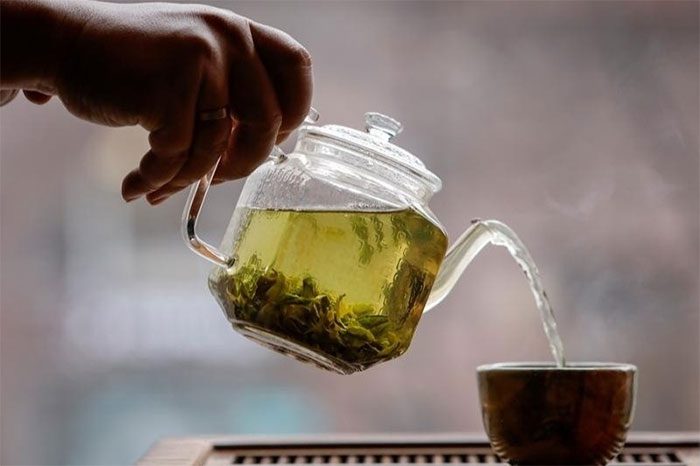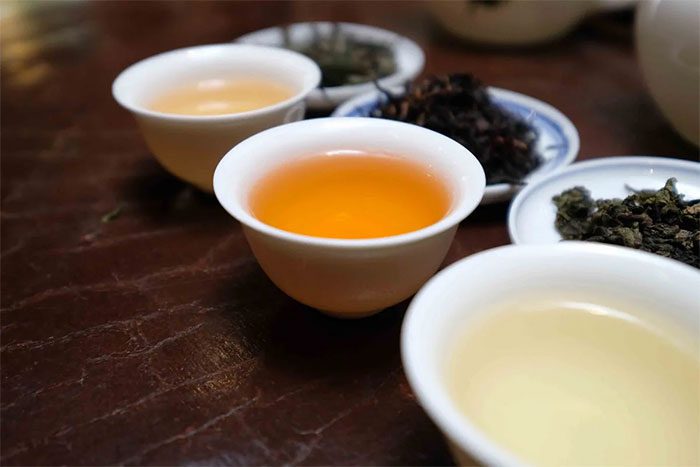Tea is a beverage that has been enjoyed by humans for a long time throughout history due to its delicious and elegant flavor.
From ancient times to the present, tea has been proven to be one of the healthiest beverages, promoting beauty and increasingly favored and widely used.
There are many types of tea such as green tea, black tea, and oolong tea… Among them, oolong tea has a unique processing technology that creates a distinct flavor. Additionally, oolong tea also has many beneficial effects on health and beauty.

Natural components in oolong tea leaves can slow down the aging process. (Photo: Reuters/Shamil Zhumatov/Illustration).
The Essence of Tea Leaves
According to traditional Eastern medicine, tea has a sweet and bitter taste, and is cool in nature, affecting the five organs: heart, liver, spleen, lungs, and kidneys. Its bitterness can help relieve conditions (purge), reduce dampness, and counteract adverse effects. The sweetness of tea is nourishing, harmonizing, while its coolness helps clear heat, purge fire, and detoxify.
Oolong tea is a precious variety of tea, originating from China, and is widely cultivated in Fujian, Guangdong, with the most famous production in Taiwan.
Oolong tea is processed using a partial fermentation method (about 20-70%) and the product has a characteristic round shape. It has a very fragrant and persistent aroma, a strong flavor, and produces a green or yellow-green infusion with green leaves.
Oolong tea is made from the tea plant (Camellia Sinensis), belonging to the family Theaceae. Camellia Sinensis originated in Southeast Asia, but today it is widely cultivated in many parts of the world in tropical and subtropical regions.
All types of tea like green tea, black tea, and red tea (oolong tea) are processed from this species. After being harvested, depending on the processing method and oxidation level, we obtain different types of tea products.
For example, black tea is fully fermented and then dried, green tea is fresh and not fermented, while oolong tea (also known as red tea) is green tea that undergoes partial fermentation.
Due to its semi-fermentation process, the enzymes in oolong tea are very beneficial for those with cardiovascular diseases, high blood pressure, as well as liver and kidney issues. Simply put, oolong tea is green tea that has gone through a semi-fermentation process.
Oolong tea is grown in mountainous regions across Vietnam, primarily in Thai Nguyen, Moc Chau, Yen Bai, and Lam Dong.
To produce oolong tea, careful selection is required from high-quality green tea buds. The tea must be hand-picked, ensuring each branch has one bud and two young leaves.

The best time to drink tea is in the morning, after waking up and at least 30 minutes to one hour after breakfast. (Photo: Pixabay).
After that, the young tea buds are withered and continuously processed with heat to create the distinct characteristics of oolong tea.
Thanks to this unique semi-fermentation method, oolong tea, even without any added flavoring or additives, still delivers a very pure flavor and contains many nutrients beneficial for health.
Benefits of Oolong Tea
Oolong tea is well-known for its exceptionally beneficial health effects. The semi-fermentation process helps oolong tea retain its polyphenol content, a substance that enhances the activity of SOD (superoxide dismutase) enzymes, helping to prevent free radicals and reduce the risk of cancer.
Moreover, the natural components in oolong tea leaves have the ability to slow down the aging process and reduce the formation of freckles and wrinkles.
Recently, scientists have discovered that oolong tea can activate the basic metabolic rate. This metabolic process generates the minimal energy required to maintain essential functions.
The polyphenols in tea help neutralize reactive oxygen species, a harmful type of oxygen produced in the body. A body with a good metabolic process and minimal reactive oxygen levels can prevent diseases such as cancer, atherosclerosis, and cardiovascular issues.
Oolong tea helps reduce the risk of diabetes: Studies show that the polyphenols in oolong tea lower blood sugar levels. They also reduce insulin resistance, a condition where the body does not use blood sugar properly. High blood sugar and insulin resistance are both risk factors for diabetes and other health issues like obesity. Dr. Tim Bond noted a study published in the journal Diabetes Care in 2003 involving 10 men and 10 women with pre-existing diabetes, which showed that drinking over one liter of oolong tea daily for 10 weeks significantly reduced blood sugar levels.
Oolong tea helps manage weight: Research indicates that oolong tea can reduce body fat and enhance metabolism, decreasing the risk of obesity and aiding weight loss. Studies show that oolong tea stimulates fat burning and increases the number of calories your body burns by up to 3.4%.
Oolong tea supports cognitive function: Oolong tea contains a high amount of an amino acid called L-theanine, which studies have shown to have cognitive benefits such as improving brain function, better sleep quality, and reducing stress and anxiety. Additionally, the antioxidants in oolong tea have neuroprotective properties, which may help prevent neurodegenerative diseases, causing parts of the nervous system to cease functioning. Researchers continue to investigate the potential of tea in preventing cognitive decline-related diseases, such as Alzheimer’s and dementia.

The antioxidants in oolong tea have neuroprotective properties.
Researchers say that the high concentration of antioxidants in green tea known as catechins may be beneficial for health.
Green tea catechins, particularly EGCG, can help reduce the progression of coronary artery disease through their effects on bad LDL cholesterol.
Drinking tea also suppresses appetite, preventing the body from absorbing too much fat, and promotes metabolic mechanisms that increase energy expenditure.
The best time to drink tea is in the morning, after waking up and at least 30 minutes to one hour after breakfast.
After a long night, the body loses a significant amount of water, so drinking a cup of tea every morning replenishes hydration and can lower blood pressure, reducing fat absorption from food.
Additionally, after salty or oily meals, drinking a cup of green tea about 30 minutes later can help diurese, eliminating excess salt from the body.
The components in tea support digestion and reduce the absorption of fats in food, as well as vitamins that the body needs.
Note on consumption of oolong tea: Since oolong tea contains caffeine, consuming it in large amounts can cause adverse side effects such as headaches, discomfort, increased heart rate, and insomnia. Experts recommend not exceeding 400 milligrams of caffeine per day, equivalent to one cup of oolong tea containing about 38 milligrams per serving.



















































